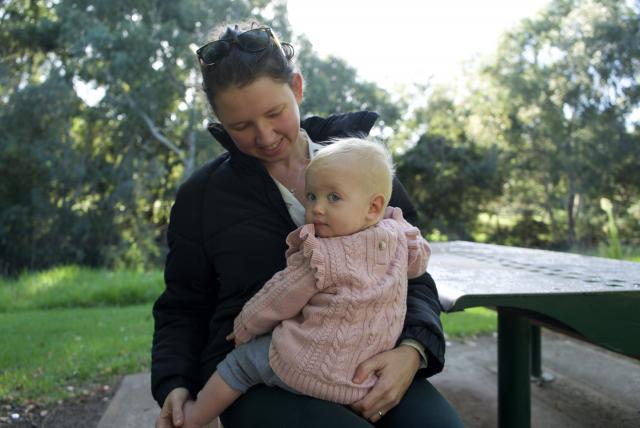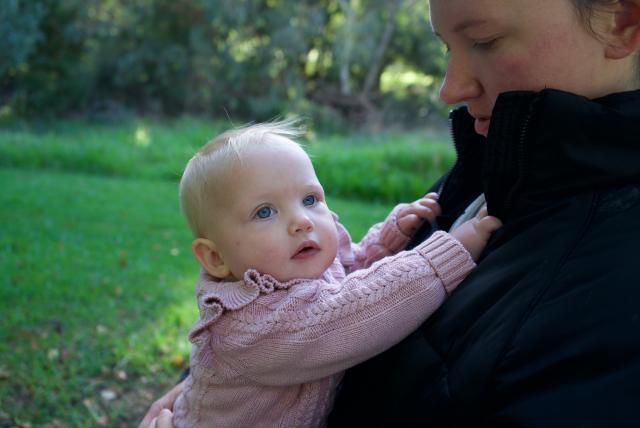
Elsie Lange
Data released by the Mitchell Institute at Victoria University this month highlighted the difficulty many families face in accessing childcare across the country. Families in the Macedon Ranges tell Elsie Lange what it’s like trying to secure quality care for their children.
It was when Romsey resident Mara Lazdins was at a mother’s group with her daughter Evija that she realised she might be on the backfoot when it came to getting into a childcare centre.
As a first time mum, she had no idea how difficult access to childcare would be in the Macedon Ranges.
“They don’t teach you that in pregnancy school,” Ms Lazdins said.
She and her husband started hunting around for care when Evija was three months old, and have only now, nine months later, secured a place at a new childcare centre in Romsey.
The couple are relieved, but it was a journey that was far from easy. Ms Lazdins said they were lucky her husband was able to work from home one day a week, while she went out and worked as a nurse.
“It’s interesting, you read on the Facebook Macedon Ranges pages, [there are] posts saying ‘Hey, we’re moving here, we’re a young family, we need daycare’, and you sort of look at it and think ‘Good luck because everyone else needs daycare as well’,” she said.
According to research by the Mitchell Institute at Victoria University released last week, Macedon Ranges exists in a ‘childcare desert’.
That is to say, there are more than three children vying for each childcare place available in the municiaplity.
Macedon Ranges residents are among the nine million Australian families in the same position.
The data paints a picture: in Romsey there are 7.6 children per childcare place, in Riddells Creek there are 6, and in Kyneton there are 5.7.
Ms Lazdins said she was told “You have no chance”.
Hannah Matthews, a policy fellow at the Mitchell Institute and author of the report, said the findings highlighted how difficult it is for families in the region to get into centre-based daycare – which forces them to consider their options.
“One of the interesting things we found here is… the wealthiest areas are able to charge the highest fees and therefore have the highest levels of childcare accessibility,” Ms Matthews said.
“This is talking about the private model that we have… where providers are able to determine where they can establish their services.
“But the other thing that we found was where we have children under five, from mothers or carers who are living in a childcare desert, there’s also a correlation there with lower levels of workforce participation… because if you have low levels of childcare, then it’s really difficult for mothers to make decisions about work,” she said.
Federal Bendigo MP Lisa Chesters said the new data backs up what she’s heard on the ground, and described the situation as “a crisis”.
“They say it’s an issue that’s left up to the market, well the market has failed to deliver enough childcare places for the families in Kyneton in the Macedon Ranges,” Ms Chesters said.
She said while making childcare more affordable through lifting the subsidy cap, the federal government would also have to improve access.
“There’s no point providing cheaper childcare if you don’t have the places,” she said.
“We need a dual approach: we need to increase places as soon as possible, by looking at local solutions, and then we need to encourage a greater build over the long term.”
Childcare, which is under federal government jurisdiction, is set to be a hot issue at May’s federal election.
In 2018, the Coalition government introduced a Child Care Package, which included a child care subsidy (CCS), following an inquiry by the Productivity Commission into the childcare system.
A 2021 evaluation of the package by the Australian Institute of Family Studies said analysis of the data at the time the CCS was introduced, and of the following 18 months, showed “no marked changes in access to child care”.
“There are though large differences in access geographically, and issues for children with additional needs,” the evaluation said.
A spokesperson for the acting Education Minister Stuart Robert said the Morrison government was proud of its investment in child care.
“This will be around $11 billion in 2022-23, including reducing the costs for families with more than one child aged five and under in care,” the spokesperson said.
“We introduced the Child Care Subsidy in 2018 to reduce the cost of child care, with low and middle-income families receiving the greatest benefit.
The government says it is tackling ’market gaps’ by investing in a Market Strategy to be delivered by September this year. The strategy will provide “information to government, providers and families to buoy competition and guarantee effective consumer choice“.
“Women’s workforce participation has reached a record high of 62.4%,” added the spokesperson said.
However, this is not the experience of Romsey mum Danielle Corner who has had to decline multiple job offers because her family didn’t have access to childcare.
Ms Corner was two months pregnant when she put her unborn child on one of the local daycare waiting lists.
Her baby is now 15 months old and when she recently called the centre for update, she heard she was still number 62 on the list.
With some sheer luck and immense persistence, Ms Corner managed to secure her daughter a childcare place so she could commence tertiary study, but it didn’t last long.
“Because she got sick all the time, I had to stop studying, but we couldn’t afford to lose our place,” Ms Corner said.
“We did find out there was a new centre opening and we waited while paying the other one… in the end she kept getting too sick and we knew the other centre was only two weeks from opening, so I pulled her out of that one in January, and the new centre opens tomorrow.”
Gisborne resident Nicole, who did not want her surname published, has to drive a long way to ensure her child is looked after while she goes to work three days a week.
“Because I’m working, I kind of had no choice,” she said.
She said she wanted to go back to work full time, but couldn’t commit because daycare was so expensive.
“I can’t even get a spot, anyway,” she said.
Kirsty Long is the new director of the recently-opened Romsey Learning Centre and said parents had been “emotional” when she told them they’d secured a place.
“I’ve had parents come in after having their child at the first day of orientation and just thanking me, our service and our company for having what they need from us,” she said.
Nicole simply said when it comes to childcare centres in the region, “there’s not enough”.
“It’s obviously across the board with every mother in the Macedon Ranges,” she said.
Have you had trouble accessing childcare in your area? Let us know your experience at westeditorial@starnweekly.com.au










